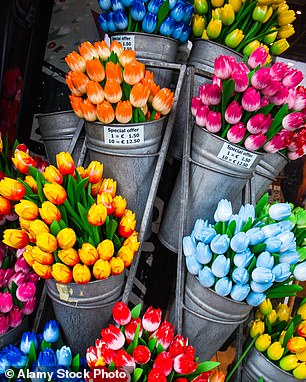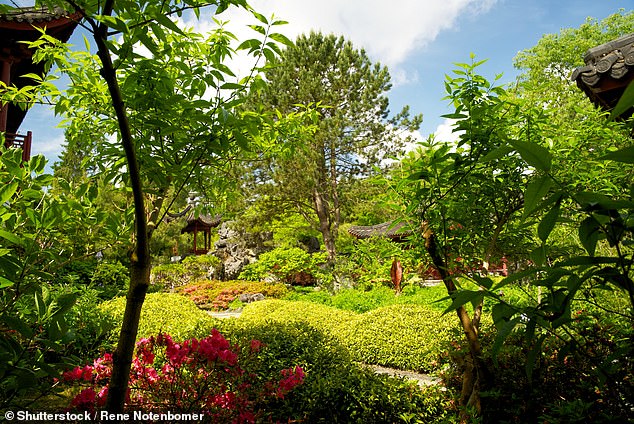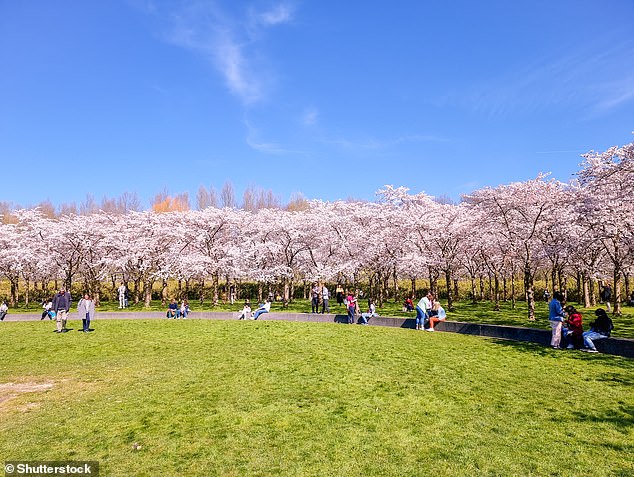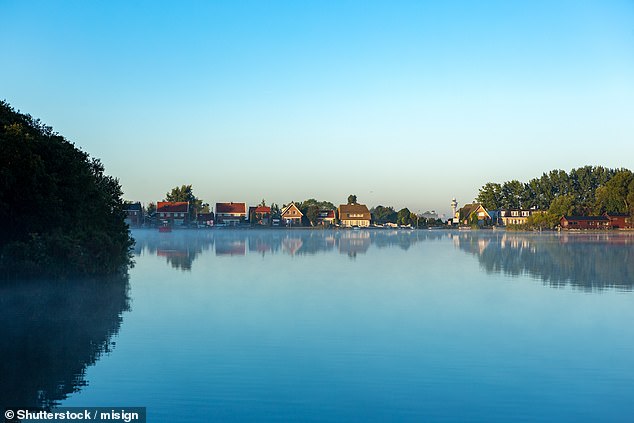My host slips into a pair of old wooden clogs then steps out into her garden. ‘They’re so warm,’ she says as if talking about a pair of favourite slippers. ‘Wood is a great insulator, perfect for gardening.’ Where else could I be other than in Holland?
Her plot is paved circles of old, weathered bricks, hemmed by tightly clipped box hedges, epitomising the pleasing Dutch obsession with netjes (neatness). In formal beds, allium and delphinium stand to attention in perfect straight lines.
A favourite with Dutch gardeners, the Paulownia tomentosa (foxglove tree) blooms at the end of the garden; its blue-violet flowers looking striking against the 17th-century brick wall.

Dam fine: Amsterdam’s Vondelpark, the most popular urban park in The Netherlands

Souvenir wooden tulips for sale in Amsterdam
‘Do you plant tulips for spring?’ I make the mistake of asking. ‘Those naughty straggly girls? So untidy! I don’t like them,’ comes the surprising reply.
This garden is one of 30 that was due to be included in Amsterdam’s Open Tuinen Dagen (open garden days) earlier this year. Unfortunately, it was cancelled, but hopes are high that it will be running again next June.
From the street you’d never guess the gardens are there, tucked away behind the grand houses on the impressive Keizersgracht and Herengracht canals.
All proceeds from ticket sales in normal years go to restoring historic gardens elsewhere in the city.
One such is Hortus Botanicus, a walled garden founded as Hortus Medicus in 1638 to supply medicinal herbs to doctors. Here you can take an aromatic stroll in the Snippendaal garden, named after the 17th-century botanist who first catalogued the 796 plant species grown here.
The soaring circular greenhouse, dating from 1911, is home to a 350-year-old Encephalartos altensteinii — a giant palm-like cycad. The most popular urban park in The Netherlands, and Amsterdam’s ‘green lung’, is the 120-acre Vondelpark.
It brims with joggers, roller-skaters, dog-walkers and picnickers at weekends, putting into practice what the Dutch term uitwaaien, replacing bad (indoor) air with good (outdoor) air and enjoying the positive impact of nature.

The walled garden of Hortus Botanicus, pictured above, was founded in 1638 to supply medicinal herbs to doctors
I’ve had a tip from a local guide, Bart de Zwart, that if I want to see the Dutch passion for horticulture in action, I need only hop on a bike from Vondelpark and pedal ten minutes to Sloterdijkermeer — a plot of 274 allotment gardens. Here, peultjes (snow peas) hang on frames and herb gardens thrive.
It’s a friendly place, dotted with benches and chairs in cosy circles, where gardeners sit for a borrel (a well-deserved drink, often jenever), and a friendly informal Hoi is regularly shouted my way as I explore.
South of the city, the Amsterdamse Bos, which began life as a post-war job creation scheme, is a vast park planted on a 2,500-acre piece of land reclaimed from the sea. As the terrain is wonderfully flat, the loveliest way to explore is by bike on paths that take you through woods, across grassland, over bridges and along lakeside paths.

Amsterdamse Bos, above, is a vast park planted on a piece of land reclaimed from the sea

Kate Wickers enjoys views of Nieuwe Meer Lake (pictured above) while dining out on pancakes
For a view of Nieuwe Meer Lake, I stop for pannenkoeken (pancakes) on the terrace of Paviljoen Aquarius. Below, kayakers glide by, disappearing into channels bordered by high reeds and startling grey herons into flight. Back in the city, on Scheepstimmermanstraat (Shipwright’s Street) in the docklands, I get a bad case of house envy.
In the 1990s, residents were given free rein by the city council to build their dream waterfront houses with rooftop gardens.
None are open to the public, so I make do with rubbernecking, catching glimpses of the lofty green oases that crown these modern takes on 17th-century canal houses.

According to Kate, some consider Amsterdam’s floating flower market (pictured above) to be ‘too touristy’
TRAVEL FACTS
More information on Open Tuinen Dagen (opentuinendagen.nl). Doubles at Canal House hotel on Keizersgracht from £145 (canalhouse.nl). Gatwick-Amsterdam returns from £44 (easyjet.com).
Advertisement
Horticultural snobs may turn their noses up at Amsterdam’s floating flower market on Vijzelstraat (too touristy they cry), but as it’s been there since 1862 it deserves respect. Bundles of as many as 40 tulips cost a mere fiver and you can stock up on quality bulbs to plant at home.
In a city where even the humblest of kerbside flower stalls sells the choicest blooms, it’s difficult to single out one florist, but Pompon on Prinsengracht, which draws inspiration from garden and natural floral design, gets my vote.
Gazing upon the lavish bouquet of creamy pink peonies I’ve bought there as a gift for a friend, I think of the words of painter Paul Gauguin when he first set eyes on Van Gogh’s Sunflowers.
Simple pleasures, such as a stroll in the park or a visit to a garden, are now more appreciated than ever and his words seem poignant.
‘That’s it . . . the flower,’ he said. Lots of those in Amsterdam . . .
Source link : https://www.dailymail.co.uk/travel/escape/article-10016097/Amsterdam-travel-Hollands-gloriously-green-capital-never-enticing.html












